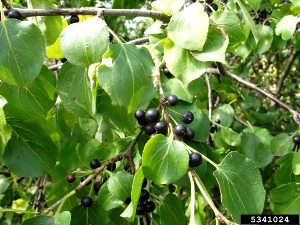Birds and mice eat the fruits of Rhamnus cathartica , which facilitates the long-distance dispersal of the seeds. This species can invade areas and become problematic. As a non-native understory shrub species, Rhamnus cathartica individuals leaf out very early and retain their leaves late in the growing season, causing the shading out of native wildflowers and herbaceous species.
Photo Credit: © Jan Samanek, State Phytosanitary Administration, Bugwood.org.
Rhamnus cathartica
Common Name: common buckthorn
Other Common Names: Carolina buckthorn, European buckthorn, European waythorn, Hart's thorn, nerprun cathartique
Plant Functional Group: Deciduous broadleaf
Class > Order > Family: Magnoliopsida > Rosales > Rhamnaceae
What does the species look like?
Common buckthorn is a deciduous, large shrub to small tree growing 3.3 to 25 feet tall. Male and female flowers generally occur separately on different plants, although the plants occasionally have flowers with both male and female parts. The small, rather inconspicuous, light yellowish-green to yellowish-brown flowers are grouped into clusters along the branches. Depending on the sunlight received at a site, flowering begins when plants mature from a few years to 20 years of age. They are insect-pollinated.
Common buckthorn occurs in moist to moderately moist areas, and occasionally on drier sites, such as roadsides, fields, thickets, woods, and wood edges. This species prefers lightly shaded sites, yet are also found in full sun. It tolerates many soil types, from well-drained sand and clay, to poorly drained calcareous soils, neutral to alkaline, and tolerates drought and air pollution.
Where is the species found?
States & Provinces
AB, CA, CO, CT, DE, IA, ID, IL, IN, KS, KY, MA, MB, MD, ME, MI, MN, MO, MT, NB, NC, ND, NE, NH, NJ, NS, NY, OH, ON, PA, PE, QC, RI, SD, SK, TN, UT, VA, VT, WI, WV, WY
Special Considerations for Observing
If drought seems to be the cause of leaf color or fall for a plant, please make a comment about it for that observation.
This species has separate male and female flowers. If you know whether the flowers you are observing are male or female (or both), please make a comment about it for that observation.
Note that individuals of this species with only male flowers will not produce fruit.
Which phenophases should I observe?
Do you see...?
Leaves
Breaking leaf buds More...
How many buds are breaking?
Less than 3 3 to 10 11 to 100 101 to 1,000 1,001 to 10,000 More than 10,000
Leaves More...
What percentage of the potential canopy space is full with leaves? Ignore dead branches in your estimate of potential canopy space.
Less than 5% 5-24% 25-49% 50-74% 75-94% 95% or more
Increasing leaf size More...
What percentage of full size are most leaves?
Less than 25% 25-49% 50-74% 75-94% 95% or more
Colored leaves More...
What percentage of the potential canopy space is full with non-green leaf color? Ignore dead branches in your estimate of potential canopy space.
Less than 5% 5-24% 25-49% 50-74% 75-94% 95% or more
Falling leaves More...
Flowers
Flowers or flower buds More...
How many flowers and flower buds are present? For species in which individual flowers are clustered in flower heads, spikes or catkins (inflorescences), simply estimate the number of flower heads, spikes or catkins and not the number of individual flowers.
Less than 3 3 to 10 11 to 100 101 to 1,000 1,001 to 10,000 More than 10,000
Open flowers More...
What percentage of all fresh flowers (buds plus unopened plus open) on the plant are open? For species in which individual flowers are clustered in flower heads, spikes or catkins (inflorescences), estimate the percentage of all individual flowers that are open.
Less than 5% 5-24% 25-49% 50-74% 75-94% 95% or more
Fruits
Fruits Rhamnus cathartica , the fruit is berry-like and changes from green to black.More...
How many fruits are present?
Less than 3 3 to 10 11 to 100 101 to 1,000 1,001 to 10,000 More than 10,000
Ripe fruits Rhamnus cathartica , a fruit is considered ripe when it has turned black.More...
What percentage of all fruits (unripe plus ripe) on the plant are ripe?
Less than 5% 5-24% 25-49% 50-74% 75-94% 95% or more
Recent fruit or seed drop More...
How many mature fruits have dropped seeds or have completely dropped or been removed from the plant since your last visit?
Less than 3 3 to 10 11 to 100 101 to 1,000 1,001 to 10,000 More than 10,000
What do these phenophases look like?
The following Phenophase Photo Guides for this species have been vetted for accuracy by the USA-NPN National Coordinating Office. Most photo guides are developed for a particular local or regional monitoring effort, and some of the content may not apply to your effort or your region. However, we make them available to provide as much help as they may in illustrating phenophases for this species. If you have high quality phenophase photos that you are willing to share with us, please visit the Phenophase Photo Guidelines page.
Be aware there is variation from individual to individual within a species, especially across different regions, so your plant may not look exactly like the one pictured.
Since they do not always include complete definitions for the species, use these photo guides ONLY in conjunction with the official Nature's Notebook phenophase defintions included in the table above, in the phenophase definition sheet that downloads with the datasheet, or in the Observe screen in the mobile app.
